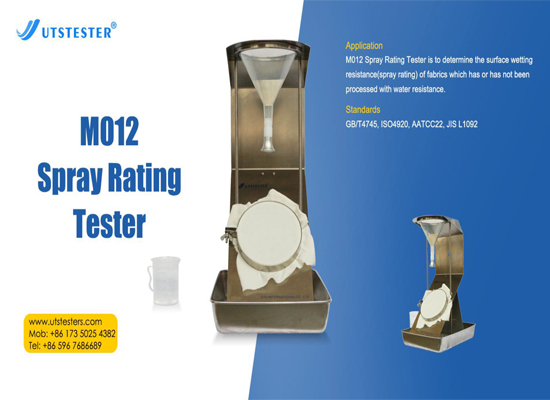 +86 152 6060 5085
+86 152 6060 5085
 +86 152 6060 5085
+86 152 6060 5085
Blog
Catalog
Latest Blog
The spray water repellent performance tester can be used to evaluate the water repellent performance of the fabric surface. The instrument has an all-metal frame. Quantitative distilled water passes through a standard nozzle and is sprayed at 45 degrees below the sample to be tested at 150mm. After the test, the surface of the sample is consistent with the standard diagram. Cards are compared and rated. It is currently the main instrument and equipment for testing the water repellency of fabrics.
A.Purpose and scope:
1. The standard applies to any textile fabric, regardless of whether it has been treated with water-repellent properties. This standard can measure the water-wetting resistance of fabrics, and is particularly suitable for textiles treated with water-repellent properties, which are plain woven fabrics.
2. Because this instrument is simple and portable, and the test procedures are relatively simple, this standard makes this standard particularly suitable for factory product control. Since this standard cannot measure the penetration of water droplets into fabrics, it is recommended not to use this standard to evaluate the rainproof penetration performance of waterproof fabrics.
3. The test results of this standard are related to the initial water repellency and wetting properties of fibers, yarns and fabrics, and have little to do with the structure of the fabric.
B.Testing principle:
Under specified conditions and procedures, water is sprayed on a taut sample to form a wetting pattern on its surface, the size of which is related to the water-repellent properties of the fabric. The evaluation result is determined by comparing it with the standard pattern.
C.Instruments and raw materials:
Spray water repellency tester; beaker; deionized water.
D.Test samples:
Three test specimens of 180*180mm (7*7inch) are required. Before testing, they need to be humidified in a standard environment with a temperature of 21±1℃ and a relative humidity of 65±2% for at least 4 hours.
E.Test procedure:
1. Place the sample on a metal ring with a diameter of 152mm, with the front side facing up, ensuring that the surface is smooth and wrinkle-free.
2. Place the metal ring with the sample on the tester's storage table. When placing it, pay attention to the position of the sample and ensure that the center of the sample ring is exactly aligned with the center of the spray pattern ring. For some twill, pique or similar stripe structures, when the sample ring is placed on the stage, the direction of the stripes should be placed diagonally to the direction of the water flow.
3. Pour 250ml of deionized water with a temperature of 27±1°C into the funnel of the tester and let it spray onto the sample within 25-30 seconds. When pouring deionized water, do not touch the beaker to the funnel. If the funnel moves, it will change the sample spray pattern, shape, etc. The spray time must be between 25-30 seconds, otherwise the nozzle must be checked to see if its hole is enlarged or blocked.
4. Hold one side of the sample ring, put the sample face down, tap the other side quickly against a hard object, and then rotate the sample horizontally 180 degrees. , hold the original knocking point and tap the original holding point quickly again to knock off the unwetted water droplets on the surface of the sample.
5. Repeat the above steps to test the remaining two samples.

Email: hello@utstesters.com
Direct: + 86 152 6060 5085
Tel: +86-596-7686689
Web: www.utstesters.com